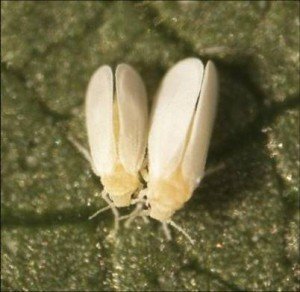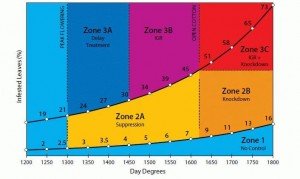We have received numerous enquiries about whitefly in the last week especially from the MacIntrye and Lower Namoi areas. Shortages of chemicals to control whitefly is currently of major concern to many growers and consultants in this region. Many enquiries also relate to species identification.
Whitefly samples identified from the MacIntyre and Lower Namoi areas have been 100% B biotype (SLW). Parasitism levels recorded from this area are low at this stage (between 0-10% parasitism).

Figure 1. B biotype, Bemisia tabaci (Photo: R. Lloyd)
Whitefly numbers are building quickly with infestation levels rising rapidly from well below threshold to threshold levels. Rainfall in the next week may assist in reducing population build up by dislodging eggs and nymphs from leaves and slowing development during cooler weather.
Whitefly infestations have put additional pressure on supply of registered insecticides. No new supplies of whitefly insecticides will be available until the week of 8 February 2010. Admiral® will be available on the 8 February and Pegasus® will be available later in February.
So what is the management strategy given the chemical shortage?
For early planted cotton, there will be no Pegasus® available in time to benefit these crops. Therefore, whether infestation levels are in the ‘suppression’ zone in the threshold matrix or the ‘IGR’ zone (see fig. 2) becomes irrelevant because the only option will be an Admiral® application.
Do not use Admiral® too early. One well-timed application of Admiral® will take the crop through to harvest. Going too early risks having to come in with another spray. Only one application of Admiral® is allowed per season under the IRMS.
For growers who already have open cotton and are above threshold, the options are:
1) Apply Admiral® as soon as it becomes available
2) Apply a knockdown now and follow up with Admiral® as soon as it becomes available
Provided whitefly infestation levels are not too high, delaying treatment up to 10% open cotton should not result in damage from whitefly. Given the weather forecast for rain and cooler weather in the next few days, consider waiting for Admiral® to become available. This will put you into the 3C zone, ‘IGR + knockdown’, eg Admiral® + Talstar® + PBO.

In a situation where hot weather is predicted and where cotton fields are looking visibly ‘sticky’, then a knockdown spray followed by Admiral® is suggested. However, a knockdown application will only give around 3 days of relief and will destroy any natural enemies that are working for you.
For later planted cotton, Pegasus® may be available for use against moderate infestations. However, as early cotton is defoliated, late cotton may be subject to mass migration of whitefly from early cotton fields and so Admiral® may again be the best option for control.
Whitefly levels in other regions
Emerald – whitefly were generally at moderate levels and were managed with a Pegasus® application that also targeted mite and aphid infestations. Parasitism levels were high ranging between 45-90% for this area.
St George – whitefly are building up with parasitism levels generally around the 35% level at this stage.
Darling Downs – there are reports of B biotype building up in the west as well as high populations of Greenhouse whitefly in the Brookstead area. Greenhouse whitefly do not cause sticky cotton so always check the identity of the whitefly as part of your management strategy.
Further References
The whitefly threshold matrix and all the information for sampling can be found in the Cotton Pest Management Guide.
